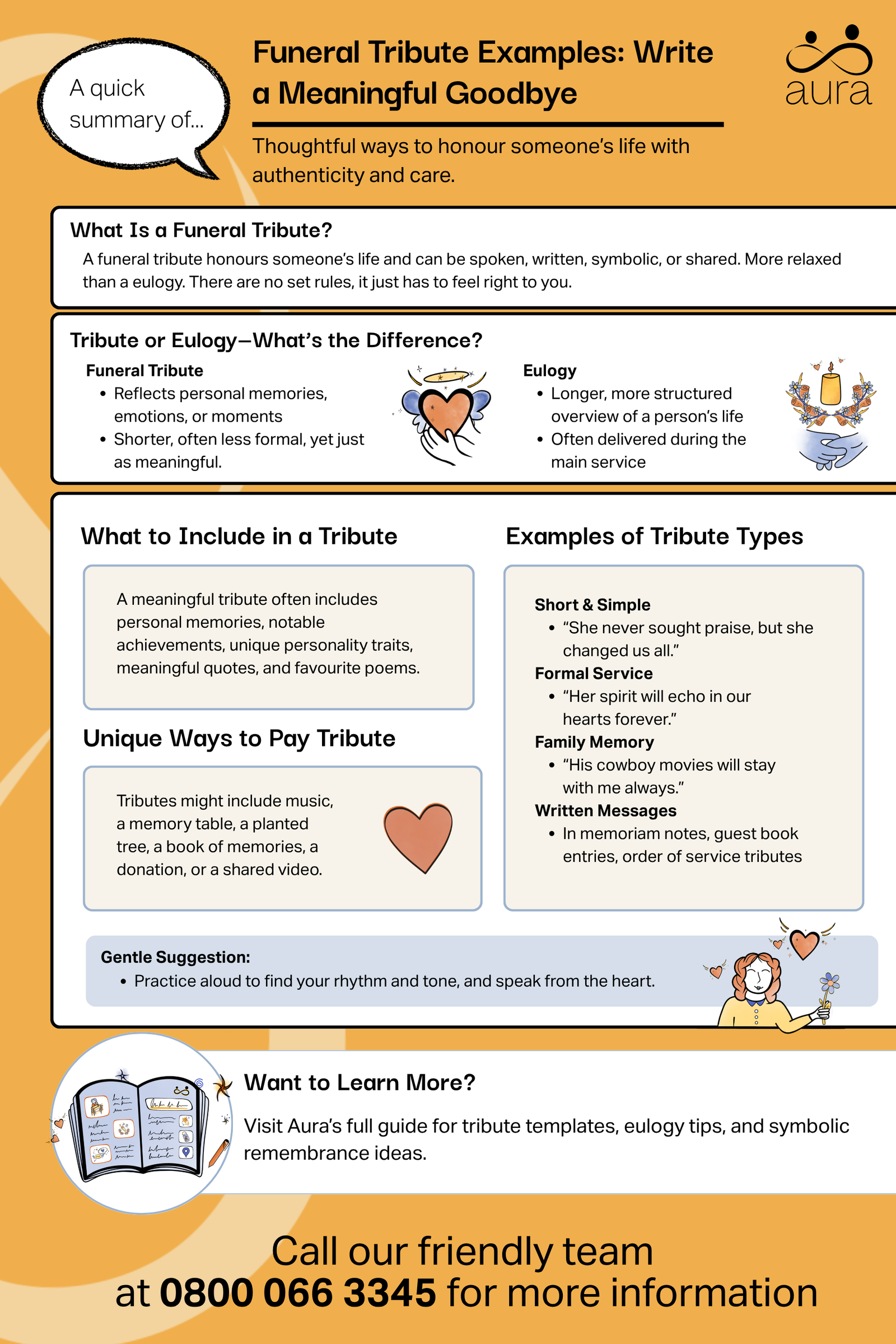


Written by Emily Cross.
18 minute read
When someone close to you has died, knowing how to carry on with daily life can feel overwhelming. One thing that some people find helpful is to focus on making funeral arrangements, which can serve as a welcome distraction.
Making decisions about funeral tributes, funeral flowers, the venue, and the service itself can offer a sense of purpose—something to channel your energy into when everything else might feel out of your control.
Over the years of offering direct cremation services that give families the space to grieve in their own way, we’ve come across many moving and meaningful examples of funeral tributes.
In this guide, we have included a variety of different examples of tributes for funeral services that you may wish to consider. Exploring how to pay tribute at a funeral service is something that may feel difficult, but with a few initial ideas and the time and space to reflect, we believe you will be able to find something that feels right.
Key takeaways:

Before we explore different examples of tributes, we need to say a few words about the purpose and nature of a funeral tribute. The terms “tribute,” “speech,” and “eulogy” are often used interchangeably at times, which may cause a little confusion. The following section will hopefully clarify this for you.
A funeral tribute, sometimes referred to as a “death tribute,” is a way of honouring and celebrating the life of someone who has died. The idea is to say a few words that reflect how you feel about the person who has died, what they meant to you, and the legacy they left behind.
Some will approach the funeral tribute as a way of giving thanks for having known someone, while others find that acknowledging and reflecting on their achievements or personality is more suitable. The choice is a personal one and not something you should feel you have to rush into making. That said, you may find that with the day of the funeral service approaching, you need to set aside some time to think in detail about how you want to approach things.
Because each of us processes and figures out how to deal with grief our own way, there is no set formula on how to go about creating your funeral tribute. What many people find helpful, however, is to sit or walk while looking back on the time they spent with the person who has died. Doing so may be a way of giving yourself the distance from recent events that allows you to remember key moments or a story that comes from the heart. You could then sit with the memory and think about how you can use particular turns of phrase or quotes to polish it in a way that your fellow mourners will appreciate.
Giving a funeral tribute speech is something that takes a prominent place amongst any list of British funeral traditions you may wish to follow. Paying tribute to someone who has died may feel like a very emotional thing to do, especially if you are not used to speaking publicly. To help navigate the process, you may find it useful to consider the following common elements that many people decide they want to use:
There is no right or wrong choice here, only what you feel is appropriate given the circumstances. A period of quiet reflection followed by a talk with a close friend or relative may help you to decide which way you want to approach things. You could even include multiple elements from the above list if you feel that doing so provides the most natural result.
Eulogies and funeral tributes are often used interchangeably, but traditionally, the two terms have distinct meanings.
A eulogy will typically be more formal, delivered during the main part of the funeral service, and will often include a broad overview of the life of the person who has died. This is different from a funeral tribute that will typically be shorter, more casual, and may not occupy quite such a prominent position during the course of the funeral service. That said, there is a considerable amount of overlap in the case of alternative funerals.
Although you might consider such a distinction in detail when you want to get the tone right, you may find it helpful to seek clarification from the funeral organiser. Doing so will enable you to create a suitable tribute with the peace of mind that comes from knowing that you’re beginning from an appropriate starting point. If you feel like you would like to learn a little more about the distinction or you are simply looking for inspiration, our guide on eulogy templates may prove insightful at this point.

Finding your desired choice of words for a funeral tribute is something that may come naturally or you may find that you need inspiration. We are never here to judge, only to help and provide support, so we want to take a moment to share a variety of examples with you. Using them as starting points may help you to put your thoughts down on paper in a way you feel comfortable with.
Expressing your emotions while remaining calm and feeling like you’re in control may be easier if you deliver a short and simple funeral tribute. Consider this example of a tribute to a mother who has died:
“Her dedication to her family was set alongside unwavering patience and a clear sense of right and wrong that touched the lives of everyone she met. She never sought the limelight or went in search of praise, and yet she is someone we still all turn to even though she is no longer with us. May we remember her with love because our lives have become richer and more meaningful for having known her.”
This short, impactful tribute conveys emotional connection, a deep sense of meaning, and an enduring legacy in just a few short lines.
If the family decides that these modern end-of-life celebration ideas are not for them and instead chooses a traditional service steeped in formality, a certain tone may be required. Consider this excerpt from an extended formal tribute:
“At a time and place where we have met to bid farewell to Jane, let us carry forward the love and laughter she so memorably brought into each and every one of our lives. Her spirit will forever echo in our hearts, have a place in our minds, and be there to remind us to cherish every moment with the ones we love.”
The use of creative, evocative language is designed to create imagery that gives everyone listening to it the time and space they need to reflect on how they feel.
Personal stories are a common way to pay tribute to someone in the family. This example of a tribute to a late grandfather serves to highlight the power of sharing a memory:
“Going over to see my grandad was the highlight of countless weekends. His homemade juices, old cowboy movies, and beautifully mowed lawn will stay with me for the rest of my life.”
A written tribute can take many forms, and exploring your options may help you decide which approach feels right for you.
Including a few words of thanks in your order of service may also help to provide a sense of comfort to all those who have come to the service. An example of how to do this is as follows:
“The family of Mark wishes to express their heartfelt gratitude for your presence today, as well as the shows of support in the weeks since his untimely death. Mark’s passion for airplanes, his love of boxing, and his joy at playing with his nephews will live on with the memories he has left us all.”
You may also be asked to write a short message in a book of condolence, either in person or online. A warm, respectful, and heartfelt message that describes their impact on your life and how you wish to remember them may serve as a fitting tribute that will be cherished by the family for many years to come.
Knowing what happens at a funeral may help you to decide whether or not the way you are considering paying tribute is appropriate. While we all have the right to pay tribute in a way we feel comfortable with, you may find that understanding what the close family and next of kin expect in terms of tone, style, and duration provides you with peace of mind. As a starting point, we have created memorial service guidance that you may find helpful at this point.
Finding creative ways to honour the person who has died allows you to extend your range of potential tributes beyond spoken tributes. With this in mind, here are some common examples that you may find helpful to consider:
Being kind to yourself and remembering that the idea is to look for authenticity rather than to chase perfection may help you strike the right balance. It’s natural that you want to make sure everything goes well on the day of the service, but working on your tribute to the point where it causes stress or anxiety may not be the kindest way to treat yourself. You have already put so much thought and care into your tribute that everyone who sees it is sure to recognise what the person who has died clearly meant to you.
Collaborative tributes, such as family members sharing short memories, could be a way to approach this that you feel more comfortable with. Rather than feeling like the onus is on you to get everything ready, working with other members of the family may help you share ideas and begin to come to terms with what has happened.
A video or a tribute book may be ways you wish to consider, but there is no formal tradition here that you should feel you have to be aware of. Talking with the other members of the family who wish to be a part of the tribute may help you to settle on a choice of media that you feel comfortable with.
Tradition may dictate flowers, but there is now a wide array of alternatives to funeral flowers if you are looking to make a symbolic funeral tribute. Many families will expressly ask for flowers not to be sent, in which case you may wish to consider the following options as starting points:
Some reading this may find that a symbolic tribute is something they find more comfortable and natural than a prepared written tribute delivered to an audience. Taking some time to sit with your thoughts and reflect on your emotions may help you decide which approach you feel most comfortable with.
A funeral tribute, while meaningful to give, should also reflect the tone and flow of the overall service. This applies whether the family has opted for a traditional funeral or has chosen one of the more modern funeral alternatives that are becoming increasingly common.
Making yourself aware of some potential mishaps that people sometimes make may help you to settle on a specific form of tribute that you feel is a natural fit for the type of funeral service.
Keeping speeches and messages concise while still covering important points will help to ensure that you don’t overrun. If there are multiple tributes being paid, you may find that having each of them at just a few minutes in duration creates the right balance. If you are delivering the only tribute, you may find that it works best when you extend it to around 5-10 minutes. You may wish to clarify the approximate length required by speaking with the funeral director or organiser.
No one expects you to deliver a word-perfect speech at a time of grief and mourning, but a few practice runs may help improve your confidence. A slow, steady, and evenly paced delivery that gives everyone the time required to absorb the full meaning of what you’re saying is a good thing to aim for here. Asking a friend or partner to listen to your initial attempts could provide you with useful feedback and give you some practice in terms of managing your emotions at key parts of the tribute.
There is a balance to be struck between formality that shows respect and heartfelt personal expression that shows authenticity. Your tribute can help you to begin working through the five stages of grief and can also play a role in the emotional journey of many of the other mourners. Finding a balance between clear and accessible language and more evocative wording that comes from the heart may help you at ease with your tribute. Having a friend listen to your practice runs could help you make the subtle adjustments that can make a real difference.
We take the time to help and reach out in any way we can and hope that you have found support in the words you have just read. If you would like to learn more about ways you could approach things, we have linked to a variety of guides throughout the passages above. We are also always available to assist with any practical matters you may have to consider at this time.
We have a guide that will compare funeral plans so that you can gain a clearer understanding of your various options, and we also offer prepaid funeral plans that could help you get your own affairs in order. Regardless of how you think we can help, we are always here, ready and waiting to offer a listening ear and a kind word whenever you need us.



If you have any questions, would like a brochure or simply would like a chat through our services, our award-winning team is here to help.
Unlike other providers, we won’t hassle you with constant calls. We’ll simply ensure you have the information you need and leave you to come to a decision in your own time. When you’re ready for us, our team will be ready to help.
One of the most effective ways we have found is to take time away from things and sit and reflect on what the person who has died meant to you. Your words are your own and your feelings and memories are your own. Having some time to yourself may help you bring them together in a way that you feel is right.
A eulogy will typically be based on a beginning-middle-end format. The beginning highlights your relationship with the person who has died to provide context that will give greater meaning to the words that follow. The middle is the longest part and is where you share stories, and memories, or simply lay out their life and what they did along the way. The end is typically the most emotionally powerful part and is where many speakers choose to directly address the person who has died.
Writing may not be something you have all that much practice with or it may be something you do every day. Regardless of where you sit, recognising writing as a way to clarify your thoughts and process your emotions may be helpful. Sitting with your thoughts and noting down memories and quotes that come to mind may be a way you can start things off.
A funeral speech is your chance to pay tribute in a way that will also help the other mourners to feel a connection with the person who has died. You will typically build the speech around a selection of memories and shared experiences that others can relate to, allowing them to see elements of their own relationship in the one you had with the person who has died.
Funeral tributes do not necessarily have to be formal, even though traditionally they have been perhaps more formal than they typically are today. Judging the level of formality of the service itself by thinking about what you know of the family and the next of kin may prove helpful here. If you are unsure, you may find it helpful to speak to the funeral director who may be able to provide some insight at a time when you may not feel comfortable asking anything of the close family.
Sharing memories of an older relative and talking about the things only they knew or the little habits that still make you smile could be an approach you wish to explore further. Memories and quotes from a loved one have the ability to make everyone else feel like a part of them is still there in the room. If the family finds humour is a useful coping mechanism, you may find that a few lighthearted memories and moments can add an air of authenticity.
Yes, you deliver a religious tribute if you feel it fits with the rest of the service and the belief system of the person who has died. Others find comfort in reading a poem whereby the creative use of language enriches what they have to say in a unique way that feels like it comes from the heart.
Not every funeral tribute has to be delivered orally to an audience during the service. Symbolic tributes are becoming increasingly common and can help deliver some sense of permanence at a time when it is natural if you are struggling to emotionally process change. Memorial benches, trees, plants, and even a piece of art could each add something authentic and thoughtful that others will appreciate.
staging site last replicated: MISSINGNO.